Wildlife ecology
Graeme Caughley studied the interactions between large mammalian herbivores and the environments they occupy. He argued that the dynamics of mammalian herbivore populations are comprehensible only in terms of an interactive relationship between the herbivores and vegetation and that efficient management of such systems requires an understanding of the underlying mechanisms whereby the animals react to the plants and in turn the plants react dynamically to the effects of grazing.
He was best known for his contributions to the understanding of herbivore-vegetation dynamics in the New Zealand high country, the Himalayas, southern Africa and the semi-arid rangelands of Australia. He influenced important management policies ‘ deer populations in New Zealand, kangaroos in Australia and the conservation of large mammals in Africa and North America and his work continues to have a major influence on thinking and practice in the field of vertebrate ecology and wildlife management throughout the world. He wrote influential books on animal ecology, was elected a Fellow of the Australian Academy of Science in 1992 and won the CSIRO Chairman’s Medal in 1993.
First interactions with CSIRO
Graeme Caughley’s first interactions with CSIRO began in 1960 when after completing his BSc degree from the University of New Zealand he moved to the School of Biological Sciences in the University of Sydney to undertake research for the MSc under the supervision of Charles Birch and Harry Frith, Chief of the CSIRO Division of Wildlife Research. His topic was the comparative ecology of Red and Eastern Grey Kangaroos (Macropus rufus and M. giganteus) on the CSIRO sheep station, ‘Gilruth Plains’, near Charleville. The MSc was conferred in April 1963 and from it Graeme published papers on the social organisation and daily activity, density and dispersion of the two species, and on sex ratios. These were the first papers to be published on social organisation and activity of any species of kangaroo.
Return to New Zealand
At the end of 1962 Graeme returned to the New Zealand Forest Service to begin a study on the population dynamics of alpine mammals, particularly the Himalayan Tahr (Hemitragus jemlahicus). In 1965 this work became the basis for his PhD from the University of Canterbury, awarded in 1967. His supervisors for this were Bernard Stonehouse and Euan Young but, as Young said: ‘Not that anyone actually supervised this work. His understanding of population processes even then was much superior to ours’.
Using new definitions of birth and death rates, he proposed a mathematical framework for analysing the dynamics of seasonally breeding populations, such as the Himalayan Tahr and domestic sheep to show that the basic equations used in demography could not be used to cover all populations, especially those species with restricted annual breeding seasons. The two papers describing this work are regarded as classics in mammalian demography and, as Charles Krebs later said, he single-handedly put large mammal ecology into a theoretical framework
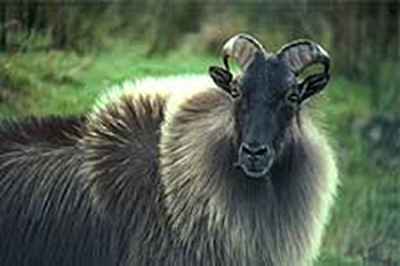
On completing his PhD Graeme undertook a series of consultancies as a wildlife biologist for the Food and Agriculture Organisation of the United Nations (FAO) with visits to:
- Nepal in 1968 to make observations on the distribution of Tahr in its native habitat
- Kenya in 1969 to determine the accuracy of methods for assessing density of wild ungulates
- the Pamirs in 1969 (at the invitation of the Iranian Government) to estimate optimum sustained yield for Marco Polo sheep (Ovis poli)
- Afghanistan to investigate conservation status of endangered species
- Zambia in 1971, to complete a FAO project on elephants in the Luangwa Valley, begun by John Goddard, who had died when the project had eighteen months left to run. As result of this trip Graeme refined the analyses of aerial surveys and the developed his ideas on the long-term interactions between elephants and the trees that provide it with food and shelter.
1973-79 at the University of Sydney
The period 1973-79 was spent at the School of Biological Sciences at the University of Sydney where he met Robert May (who later became Sir Robert, Baron May of Oxford), then at the University of Sydney, and was attracted by his ideas on stable limit cycles, which Graeme developed in the elephant-plant system. At the same time Graeme was developing concepts of plant-herbivore systems, to which he had been introduced by Richard Bell, while he was in Zambia. He wrote on wildlife management and the dynamics of ungulate populations in a paper that was an extended treatment of the relationship between population dynamics and population management using the ungulate-vegetation system for examples. Suggestions were given for estimating sustained yield and for managing an ungulate population to minimise damage to the vegetation. It was a powerful impetus to the development of a harvest theory for ungulates and had a profound influence on the management of large herbivores in the national parks of North America and worldwide.
In 1977, Caughley’s book Analysis of Vertebrate Populations was published by Wiley and was recognised as the seminal work on the dynamics of vertebrate populations and how such populations may best be studied. It established him as the leading ungulate ecologist and one of the top five vertebrate ecologists in the world. It is still the primary reference in the discipline and is still widely consulted.
In Australia, Caughley was becoming recognised as the pre-eminent expert on kangaroo ecology and population dynamics. In the early 1970s, animal welfare groups in the USA campaigned to have the trade in kangaroo products abolished, on the grounds of the danger they represented to the populations of red and grey kangaroos. Wildlife biologists realised that an accurate method of measuring the size of kangaroo populations was needed to resolve this dispute. Caughley applied his African experience to this problem and began to develop accurate methods of aerial census of kangaroo populations.
In early 1979, Graeme was awarded a DSc from the University of Sydney for his corpus of publications, entitled ‘The Dynamics of Mammalian Populations’ and later that year made the move to CSIRO.
CSIRO studies on kangaroo populations
In 1979, Graeme was appointed Senior Principal Research Scientist in the Division of Wildlife Research to head a program on kangaroo ecology. His aims were to determine the distribution, density and dynamics of the three main species of kangaroo across Australia, to determine appropriate options for their management, and to elucidate the ecological operating rules of the arid and semi-arid grazing systems.
He continued to develop the aerial survey techniques he had begun earlier at the University of Sydney. He developed a rigorous system of calibration and statistical treatment that has made it possible to make regular estimates of the numbers of free-ranging kangaroos across the vast areas of Australia, their movements, and the distribution of other large animals. Since 1980, these aerial survey techniques have been routinely used by the fauna authorities of the Australian states for their respective kangaroo management programs, and by Environment Australia as the basis for the Federal Government’s export quota system each year. The accurate knowledge of trends in kangaroo populations across the continent has helped to counter opposition from Europe and the USA to culling and harvesting of kangaroos. In 1986, Graeme successfully negotiated with members of the European Parliament against a proposed ban on kangaroo imports.
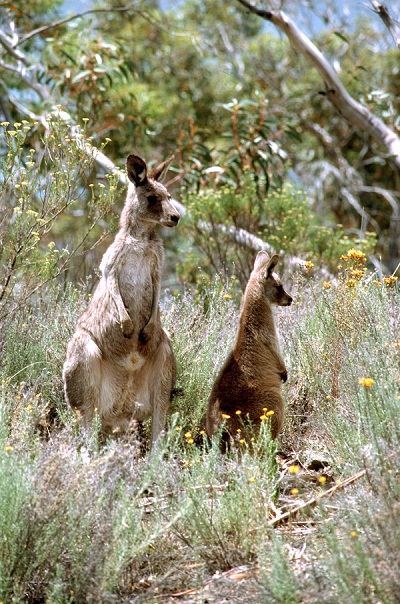
In addition to the direct application of his work on kangaroos, he also attempted to get some general principles out of the distributions of the three large kangaroos in Australia. He showed that each species reacts independently to specific and differing climatic variables and that biological interaction between species is not important. Subsequently, using much tighter data that included dynamics attributes as well as simple distribution, he ended up with generalised results about the factors determining the edge of a species’ range.
In 1983, he and Charles Krebs explored the importance of body size in mammalian ecology. Ecologists studying mammalian population dynamics have tended to base generalisations, covering all species, on results from the kinds of animals that they have studied themselves. This new analysis suggested that the ecological and evolutionary relationships between mammals weighing more than 30 kg and the plants that they eat differ intrinsically from those of smaller mammals and their food, a concept independently arrived at by comparative physiologists.
The Kinchega National Park study
Graeme’s major project in CSIRO was a collaborative one with the New South Wales National Parks and Wildlife Service, begun under the leadership of Neil Shepherd in 1977, to examine the relationship between high kangaroo densities and vegetation in an arid-zone national park (Kinchega National Park). With Graeme’s transfer, CSIRO was invited to join in and Graeme and Neil shared the leadership from 1980 to its completion in 1985.
Its aims were altered to include interactions with weather, vegetation and other herbivores and it was run as a joint enterprise, combining staff of CSIRO Division of Wildlife Research and National Parks and Wildlife Service. The scale of the project is indicated by the fact that 400 student volunteers contributed to it as well. At the time it was the largest and most comprehensive study of a complex plant-herbivore ecosystem ever attempted.
Graeme designed the joint study so that its diverse sub-projects dove-tailed to produce a synthesis of the dynamics of this grazing system. Growth, offtake, species composition and standing biomass of vegetation were measured over 600 square kilometres at frequent intervals. Kangaroos were censused regularly over an area of 200 square kilometres, necessitating some 500 hours of aerial survey.
The project identified and quantified the relationships between weather, plant growth, and rate of increase of kangaroos; it showed that the ecological relationships within the system were very tight and interactions occurred with minimum lag, despite the massive environmental fluctuations. Carrying capacity was shown to be a function of the coefficient of variation of annual rainfall. Sustainable harvesting rates and management strategies were defined.
The study, which provided the most detailed and integrated analysis to that time of any grazing system in the world, was published by Cambridge University Press as a monograph, with Caughley as senior editor, entitled Kangaroos: Their Ecology and Management in the Sheep Rangelands of Australia. In addition to the book, 31 papers were published from the study as well as nine theses (4 Honours, 1 MVSc, 2 MSc and 2 PhD).
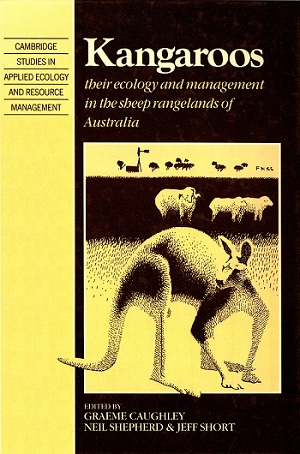
New Zealand interests
Although Graeme lived in Australia from 1973, his links with New Zealand remained strong and in 1983 he wrote an unusual book, The Deer Wars: The Story of Deer in New Zealand, published by Heinemann. In it he analysed the problem of wildlife management simultaneously from several perspectives: history, ecology, evolution, hydrology, geology, sociology, politics and economics. The book was unusual for several reasons: it was not a treatise on the ecology of red deer and the history of deer in New Zealand, although there was a lot of that in it; it was not a text on the economics and politics of managing a wildlife resource, although one can learn much about that in its pages; and it was not an autobiography, although Graeme obviously wrote from first-hand knowledge and experience. The book is a splendid example of problem-solving, vigorous and free-flowing text that examines the complex interactions between wild mammals, their environment and the perceptions and interests concerning these animals held by different groups of people within society.
Graeme took a particularly good example with which to examine the evolution of people’s perceptions of a wild species and the way in which government policy responds to these perceptions. It is the merit of this book that, while it is about deer in New Zealand, it has lessons for the management of wildlife everywhere. Biologists, conservationists and those interested in land use in New Zealand applauded the book. Its influence was profound because it appeared just before the administration of native forests was moved from the New Zealand Forest Service to the Department of Conservation.
Quaternary faunal extinctions, climate change and the dispersal of people
Sometime about 1986 or 1987 Graeme began a project on Quaternary faunal extinctions, climate change and the dispersal of people. He wanted to apply dispersal ecology and regression analysis to human ecology in order to understand the early spread of mankind across Australia. He recognised that the settlement of New Zealand by Polynesians about 1 000 years ago would provide a rigorous model for the much harder task in Australia.
In 1988, he examined the pattern of colonisation of New Zealand by the Polynesians and the interaction of the avian megafauna, the New Zealand flora and mankind. It produced results at variance with the current anthropological paradigm of rapid colonisation by Maoris of all coastal regions of New Zealand, and a long association of moas and Maoris. Instead, he proposed that the first landfall was made on the Kaikoura coast of South Island about 1 000 years ago and colonisation of both islands spread out from there at an accelerating rate, reaching 10 km a year after 400 years, when colonisation was complete. Secondly, variance stripping on the radiocarbon dates indicated that the average time that megafauna and people co-existed in any district was only about one century. The inference from this was that the human population grew and spread on the abundant food resource in much the same way as the introduced ungulates did several centuries later. This paper had an important effect on ethnography and archaeology in New Zealand and it demanded a new appraisal of the time of arrival and the pattern of spread of the Maori people through New Zealand.
In a subsequent paper in 1989 presented at a symposium of the New Zealand Ecological Society in response to the previous paper, Caughley examined the history of the New Zealand biota over the last 7 000 years. He divided it into three phases. BC 5 000 to AD 1 000 was a period of comparative ecological stasis. That equilibrium was disrupted between AD 1 000 and AD 1 800 by the destruction of most of the New Zealand plant-herbivore systems, the co-evolutionary relationships between the plants and the vertebrate herbivores being decoupled by about AD 1 400. The ecology of the moas was deduced from what data were available to show that their closest living ecological analogues are not birds but browsing mammals. Regrettably, the rest of the project, addressing the interactions of people and megafauna in Australia, was not completed by the time of his death.
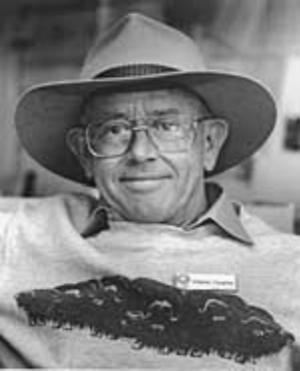
Conservation biology
Graeme was concerned about survival of species but was indifferent to individual animals. Because of his experience, as revealed in The Deer Wars, he had an impartiality as to whether animals are killed, culled or conserved and this approach is probably essential for a person who is to develop rational management policies. In the last years of his life he turned his attention more to conservation issues and the management of declining populations and away from harvesting and sustained yield issues.
In 1990, he began a project to test experimentally the effect of various stressors on the viability of small populations and, at the same time, began to gather material for a re-examination of the theoretical bases of conservation biology and the factors determining population viability. In 1994 he published a major review on the subject in the Journal of Animal Ecology and a book with Tony Sinclair entitled Wildlife Management and Ecology. In less than a year, while ill with terminal cancer, he and his partner, Anne Gunn, wrote most of an entirely new book entitled Conservation Biology in Theory and Practice. Following Graeme’s death on 16 February 1994, Anne Gunn completed the book and it was published by Blackwells in 1996.
The review and the book that followed aroused considerable debate. The book was an astonishing achievement, even without considering the conditions under which it was written. In a real sense it is a response to the appeal of the review, to provide conservation biology with a strong theoretical underpinning. This it does, and also offers a wealth of examples and practical solutions for the particular problems faced by species in decline. It is destined to be the handbook of first resort in conservation biology for years to come. While Graeme’s mind is in it all, Anne Gunn played a huge part in the support she gave him through the last months of his life and in the hard task of completing it for publication. As his friend Ian Parker wrote in the front of the book, he was thinking originally to the end
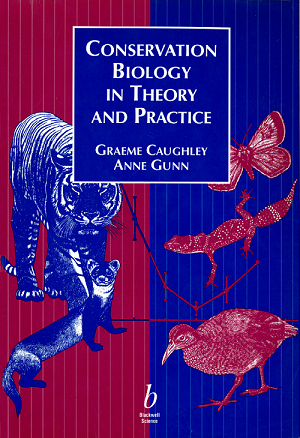
2007 Fenner conference in honour of Graeme Caughley
In 2007, a Fenner Conference on the Environment on ‘Wildlife Population Dynamics and Management’, was held at the Shine Dome of the Australian Academy of Science in Canberra in December 2007 to honour Graeme’s contribution to the field of wildlife research and management. The conference proceedings were published in the journal Wildlife Research, 36, Issue 1, 2009, ‘Wildlife Population Dynamics and Management’. The year 2007 was 30 years after the publication of Graeme Caughley’s best-known book, Analysis of Vertebrate Populations. In his foreword to the volume Jim Hone, Fenner Conference Co-ordinator for the Australasian Wildlife Management Society wrote:
The book has been used as a university textbook around the world. Dr Caughley’s research has provided a basis for kangaroo management in Australia, ungulate management in New Zealand and aspects of elephant management in parts of southern Africa. The aims of the conference were to review general and specific topics in Dr Caughley’s research, to describe recent developments in the many fields of wildlife population dynamics and management since 1977, and then, using the outcomes, to postulate on future research needs and directions in environmental and conservation problems in Australia and elsewhere.
Graeme Caughley made a significant contribution to wildlife research and management in Australia and New Zealand. We trust you enjoy reading these papers on his research and the updating to contemporary perspectives on the topics.
Source
- Tyndale-Biscoe CH, 1999, Biographical memoirs: Graeme James Caughley 1937-1994 (Australian Academy of Science)
